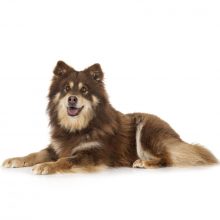Finnish Lapphund
Lifestyle Needs

The Finnish Lapphund is a working dog, bred in Lapland to herd reindeer. He is a hardy and intelligent dog who enjoys being outdoors in cold weather. His very thick and medium length coat will protect him from wind and cold temperatures. He is energetic and needs to be challenged both mentally and physically. He is not everybody’s choice of an ideal family dog although he has become a popular pet in Finland and Sweden. He will need to be carefully groomed frequently.
Genetic Diversity
(Known as Coefficient of Inbreeding: 'COI'. It should be as low as possible.)
The UK Kennel Club breed average COI is 2.3% - See 'A Beginners Guide to COI'
Gene Pool Size
(Known as Effective Population Size: 'EPS')
198.3
EPS is a measure of how many individuals are contributing genetically to a breed population. It is a measure of the size of the gene pool in a breed. Lower than 100 is considered critical by conservationists and below 50 brings a breed close to extinction. For more information see the Kennel Club article.
Health and Welfare Problems due to Conformation
(Body shape and physical characteristics)
The Lapphund is free from physical exaggerations but his thick, weatherproof coat means that he will not be comfortable in warm weather. There is a danger he will overheat.
BVA/KC Health Schemes: www.bva.co.uk/chs
- Hip dysplasia: breed 5 year mean score 13.1 (parents should be lower)
- Eye disease: Progressive retinal atrophy (PRA) (annual testing); Hereditary cataract (HC) (annual testing); Persistent hyperplastic primary vitreous (PHPV) (litter screening); Persistent pupillary membrane (PPM) (litter screening); Multifocal retinal dysplasia (MRD) (litter screening)
Estimated Breeding Values (EBVs) : No EBVs are currently available for this breed
www.thekennelclub.org.uk/about-ebvs
DNA Tests Available
DogWellNet and IPFD Harmonisation of Genetic Testing for Dogs (HGTD)
www.dogwellnet.com/breeds
- Progressive Retinal Atrophy (prcd-PRA)
- Canine Multifocal Retinopathy 3 (CMR 3)
- Hyperuricosuria (HUU)
Availability of a DNA test does not mean that it is always necessary or even desirable for breeders to use this test.
Other Breed-Specific Health Screening Schemes
None known
Ask the breeder to show you the certificates for the above tests/screening for both parents. If any of the above tests have not been considered necessary by the breeder (and there may be good reasons), ask her to explain why.
Other Diseases Reported
(For which there are currently no genetic or screening tests for sire or dam)
- Cataracts
- Osteogenesis imperfecta
Ask the breeder about the medical history of the parents, grandparents and great grandparents. Consider carefully whether to purchase a puppy if some of these or other diseases are in the family line.
Ask about the breeder’s policy in cases of serious genetic diseases occurring to your puppy in later life. Good breeders will request to be informed of such events in order to improve future breeding decisions.
You are strongly advised to buy from a breeder who uses (or is prepared to use) the AWF Puppy Contract and Puppy Information Pack (PIP): www.puppycontract.org.uk
The breeder should also be familiar with the CFSG/DBRG Code of Practice for Dog Breeding